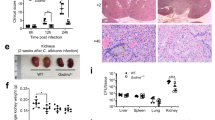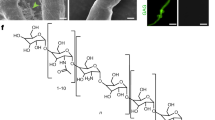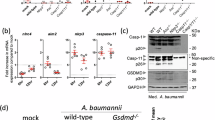Abstract
Fungal infections represent a serious threat, particularly in immunocompromised patients1. Interleukin-1β (IL-1β) is a key pro-inflammatory factor in innate antifungal immunity2. The mechanism by which the mammalian immune system regulates IL-1β production after fungal recognition is unclear. Two signals are generally required for IL-1β production: an NF-κB-dependent signal that induces the synthesis of pro-IL-1β (p35), and a second signal that triggers proteolytic pro-IL-1β processing to produce bioactive IL-1β (p17) via Caspase-1-containing multiprotein complexes called inflammasomes3. Here we demonstrate that the tyrosine kinase Syk, operating downstream of several immunoreceptor tyrosine-based activation motif (ITAM)-coupled fungal pattern recognition receptors, controls both pro-IL-1β synthesis and inflammasome activation after cell stimulation with Candida albicans. Whereas Syk signalling for pro-IL-1β synthesis selectively uses the Card9 pathway, inflammasome activation by the fungus involves reactive oxygen species production and potassium efflux. Genetic deletion or pharmalogical inhibition of Syk selectively abrogated inflammasome activation by C. albicans but not by inflammasome activators such as Salmonella typhimurium or the bacterial toxin nigericin. Nlrp3 (also known as NALP3) was identified as the critical NOD-like receptor family member that transduces the fungal recognition signal to the inflammasome adaptor Asc (Pycard) for Caspase-1 (Casp1) activation and pro-IL-1β processing. Consistent with an essential role for Nlrp3 inflammasomes in antifungal immunity, we show that Nlrp3-deficient mice are hypersusceptible to Candida albicans infection. Thus, our results demonstrate the molecular basis for IL-1β production after fungal infection and identify a crucial function for the Nlrp3 inflammasome in mammalian host defence in vivo.
This is a preview of subscription content, access via your institution
Access options
Subscribe to this journal
Receive 51 print issues and online access
$199.00 per year
only $3.90 per issue
Buy this article
- Purchase on SpringerLink
- Instant access to full article PDF
Prices may be subject to local taxes which are calculated during checkout




Similar content being viewed by others
References
Romani, L. Immunity to fungal infections. Nature Rev. Immunol. 4, 1–23 (2004)
Vonk, A. G. et al. Endogenous interleukin (IL)-1α and IL-1β are crucial for host defense against disseminated candidiasis. J. Infect. Dis. 193, 1419–1426 (2006)
Yu, H. B. & Finlay, B. B. The caspase-1 inflammasome: a pilot of innate immune responses. Cell Host Microbe 4, 198–208 (2008)
Mariathasan, S. et al. Cryopyrin activates the inflammasome in response to toxins and ATP. Nature 440, 228–232 (2006)
Bugarcic, A. et al. Human and mouse macrophage-inducible C-type lectin (Mincle) bind Candida albicans . Glycobiology 18, 679–685 (2008)
Yamasaki, S. et al. Mincle is an ITAM-coupled activating receptor that senses damaged cells. Nature Immunol. 9, 1179–1188 (2008)
Gross, O. et al. Card9 controls a non-TLR signalling pathway for innate anti-fungal immunity. Nature 442, 651–656 (2006)
Hara, H. et al. The adaptor protein CARD9 is essential for the activation of myeloid cells through ITAM-associated and Toll-like receptors. Nature Immunol. 8, 619–629 (2007)
LeibundGut-Landmann, S. et al. Syk- and CARD9-dependent coupling of innate immunity to the induction of T helper cells that produce interleukin 17. Nature Immunol. 8, 630–638 (2007)
Braselmann, S. et al. R406, an orally available spleen tyrosine kinase inhibitor blocks Fc receptor signaling and reduces immune complex-mediated inflammation. J. Pharmacol. Exp. Ther. 319, 998–1008 (2006)
Pine, P. R. et al. Inflammation and bone erosion are suppressed in models of rheumatoid arthritis following treatment with a novel Syk inhibitor. Clin. Immunol. 124, 244–257 (2007)
Mariathasan, S. et al. Differential activation of the inflammasome by caspase-1 adaptors ASC and Ipaf. Nature 430, 213–218 (2004)
Mencacci, A. et al. Interleukin 18 restores defective Th1 immunity to Candida albicans in caspase 1-deficient mice. Infect. Immun. 68, 5126–5131 (2000)
Martinon, F. et al. Gout-associated uric acid crystals activate the NALP3 inflammasome. Nature 440, 237–241 (2006)
Petrilli, V. et al. Activation of the NALP3 inflammasome is triggered by low intracellular potassium concentration. Cell Death Differ. 14, 1583–1589 (2007)
Halle, A. et al. The NALP3 inflammasome is involved in the innate immune response to amyloid-β. Nature Immunol. 9, 857–865 (2008)
Hornung, V. et al. Silica crystals and aluminum salts activate the NALP3 inflammasome through phagosomal destabilization. Nature Immunol. 9, 847–856 (2008)
Dostert, C. et al. Innate immune activation through Nalp3 inflammasome sensing of asbestos and silica. Science 320, 674–677 (2008)
Cruz, C. M. et al. ATP activates a reactive oxygen species-dependent oxidative stress response and secretion of proinflammatory cytokines in macrophages. J. Biol. Chem. 282, 2871–2879 (2007)
Muruve, D. A. et al. The inflammasome recognizes cytosolic microbial and host DNA and triggers an innate immune response. Nature 452, 103–107 (2008)
Vasiljeva, O. et al. Reduced tumour cell proliferation and delayed development of high-grade mammary carcinomas in cathepsin B-deficient mice. Oncogene 27, 4191–4199 (2008)
Underhill, D. M., Rossnagle, E., Lowell, C. A. & Simmons, R. M. Dectin-1 activates Syk tyrosine kinase in a dynamic subset of macrophages for reactive oxygen production. Blood 106, 2543–2550 (2005)
Boyden, E. D. & Dietrich, W. F. Nalp1b controls mouse macrophage susceptibility to anthrax lethal toxin. Nature Genet. 38, 240–244 (2006)
Robinson, M. J. et al. Myeloid C-type lectins in innate immunity. Nature Immunol. 7, 1258–1265 (2006)
Chen, S. T. et al. CLEC5A is critical for dengue-virus-induced lethal disease. Nature 453, 672–676 (2008)
Ng, G. et al. Receptor-independent, direct membrane binding leads to cell-surface lipid sorting and Syk kinase activation in dendritic cells. Immunity 29, 807–818 (2008)
Weinblatt, M. E. et al. Treatment of rheumatoid arthritis with a Syk kinase inhibitor: a twelve-week, randomized, placebo-controlled trial. Arthritis Rheum. 58, 3309–3318 (2008)
Li, P. et al. Mice deficient in IL-1 beta-converting enzyme are defective in production of mature IL-1 beta and resistant to endotoxic shock. Cell 80, 401–411 (1995)
Kawai, T. et al. Unresponsiveness of MyD88-deficient mice to endotoxin. Immunity 11, 115–122 (1999)
Acknowledgements
We thank C. Peschel for helpful conversations, K. Schroder for critically reading the manuscript, RIGEL Inc. for providing the Syk inhibitor R406, P. Vandenabeele for the anti-Caspase-1 antibody and V. Dixit for Nlrc4-/- mice. O.G. is supported by a Marie Curie RTN ApopTrain Fellowship. This work was supported by Swiss National Science Foundation National Center of Competence in Research molecular oncology and Mugen grants to J.T., an EMBO long-term fellowship to C.D. and a Max-Eder-Program grant from Deutsche Krebshilfe and Sonderforschungsbereich grants from Deutsche Forschungsgemeinschaft to J.R.
Author Contributions O.G., H.P. and J.R. designed the research; O.G., H.P., M.B., N.H., C.D. and A.T. performed experiments; E.S., V.T. and A.M. contributed critical reagents, O.G., H.P., M.B., S.E., G.H., C.D., J.T. and J.R. analysed results; O.G. made the figures; O.G., H.P. and J.R. wrote the paper.
Author information
Authors and Affiliations
Corresponding author
Supplementary information
Supplementary Figures
This file contains Supplementary Figures 1-6 with Legends (PDF 922 kb)
Rights and permissions
About this article
Cite this article
Gross, O., Poeck, H., Bscheider, M. et al. Syk kinase signalling couples to the Nlrp3 inflammasome for anti-fungal host defence. Nature 459, 433–436 (2009). https://doi.org/10.1038/nature07965
Received:
Accepted:
Published:
Issue Date:
DOI: https://doi.org/10.1038/nature07965



